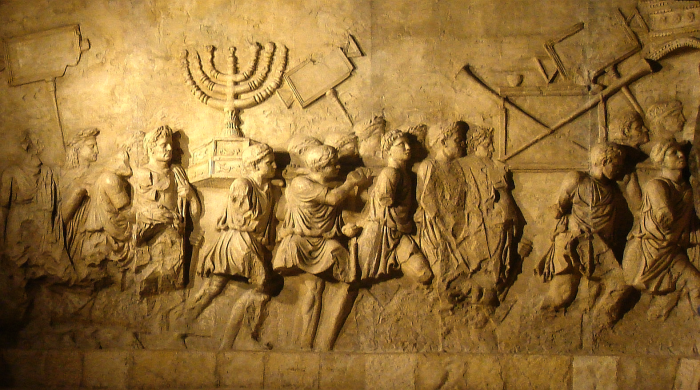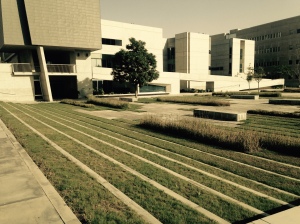I have to admit – one thing that fills me with a mix of excitement and dread on the days leading up to a tour with the Fulbright program is the tour-guide-led part of it. Not that I don’t like tours or tour guides. It’s a great way to experience something new, and more memorable than wandering around with a guidebook trying to figure out where important site #34 is on the mediocre map you’ve been provided. But a good tour guide is suppose to be an expert (or approaching an expert level of knowledge) in the contents of said tour, and relatively unbiased in her narration. Herein lies my concerns.
It is the case then, that our tours begin to feel like taglit (birthright, as it is know in the US) for grown ass intellectuals. In other words, a pro-Israel propaganda project disguised with barely a veneer of education and mutual understanding. We are Fulbrighters – current and future public intellectuals – and we want nuance, the full story, to be shown the complexity of the historical, political, economic, and cultural legacy of the country for which agreed to be cultural ambassadors (but of course in no official capacity or affiliation with the federal government or state of Israel whatsoever).
In a sense this tour tragedy is an opportunity for further education. At the very least – you would hope – in the process of correcting these errors and micro-manipulations of the truth we gain a better understanding of things here; I know for me this has been the case.
Below is a list of problematic statements that I’ve caught over the course of many tours. They vary in the degree of wrongness from ‘yes, but that’s not the whole story‘ to ‘no that is not the case at all.’ Why does this really matter? The short answer is that the ancient and recent history of the Middle East, and even the Mediterranean and Europe, are an essential component of state authority and identity narratives. This is not a unique fact; most nation states do this, ranging from innocuous truths to damaging falsities. As a social scientist, as a responsible citizen, and as a compassionate individual I feel it is my responsibility – in fact it is our shared responsibility – to question the prevailing narratives that perpetuate structural inequalities.

- Claim: Jaffa oranges were invented by Israelis.
False. You only need to google Jaffa orange to debunk this. The Wikipedia entry tackles who invented them in the second sentence. There is a documentary about the Jaffa orange, a fruit which became the symbol of Zionist enterprise and the state of Israel, while for Palestinians, it represented the loss of their homeland and its destruction.

- The immigrants of the First Aliya came to an empty country of “sand, rocks, and stone” and purchased a bunch of farms and land that had been devastated by the Ottomans
I’ve been having a hard time unpacking this one. For one, it’s not fully clear from whom this land was bought from according to our tour guide. Presumably she means Palestinians, but usually she just said Arabs and didn’t commit to naming a people in any specific way. This, of course, is problematic in itself but I didn’t spend enough time with the tour guide to get a good sense of where she stands on this. The internal logical contradictions here are also curious. For example, from whom does one purchase land in an empty country? And, if the land was so devastated by centuries of Ottoman mismanagement, why were there so many farms available for purchase? Needless to say I could write a lot about this period of time, which is very interesting, but won’t.
Here are some quick facts:
Some 2.5 to 3 million jews immigrated out of Europe (mostly eastern) in the late 19th century during the First Aliya. Of these only a few tens of thousands moved to Ottoman Palestine, and about half ended up leaving anyway because of various hardships.
While secular political motives were not a major concern of these religious families seeking refuge from persecutions such as the pogroms in Russia, political Zionism quickly found a foothold there. During and after the Second Aliya, a major focus would become the creation of a majority Jewish state in an area where Palestinian Arabs were already the majority. One solution was known as “transfer,” and would later be known as Plan Dalet, the forcible depopulation of Palestinians from their homeland.

- The Romans wanted to eradicate Judiasm
This is preposterous. The Romans were an imperial force that annexed Palestine and Transjordan. During the 1st century BCE they installed a client king, Herod, himself of Jewish descent and a man of great infamy. During the 1st and 2nd centuries CE a series of large-scale nationalist revolts by the Jews attempted to restore an independent Jewish state. The Jews, for their part, were attempting to subvert an occupying force, with absolutely no relevance to the present situation in Israel. Disagreements and ultimately revolts broke out due to a combination of ethno-religious conflict, protests over taxation, and dissatisfaction with the veneer of limited autonomy in their homeland.
The Jews had it the worst, and the empire came the closest to a true attempt at eradication, under Hadrian (r. 117-138 CE), who saw them as the cause of continuous rebellion. Hadrian essentially outlawed Judaism and executed Jewish scholars, and attempted to erase Judea from historical memory by renaming the region Syria Palestina (after ancient Israel’s enemy, the Philistines), and re-establising Jerusalem as Aelia Capitolina (after the Roman god Jupiter). Of course, to Hadrian the Jews were attempting to subvert the authority of his empire, which had been ruling there for nearly 200 years by that point. The waves of incitement by messianic figures like Bar Kochba only infuriated the emperor further.

- Abraham brought the “mother wheat” to Israel
If these events were suppose to be a tour of the literal historical geography of the Holy Land (as in, “that way is Ashkelon, where Jonah was swallowed by a whale,” a phrase actually uttered by our guide, among others) then this still doesn’t belong on the tour agenda, because: 1) In reality science says it didn’t happen that way, and 2) in the Bible it doesn’t say this happens.
Wheat began to be cultivated in the Near East (including the area of the fertile crescent in Syria, Lebanon, and Israel about 11,500 years ago. For most people who literally interpret the Bible this is 5000 years or so before the Earth is created, so… Even still, non-Young Earth literalists date the age of the Patriarchs to a much later period than this.

- Druze were persecuted by and breakaway of mainstream ‘arabism,’ and Israel gave them refuge.
The Druze are a little know minority in Israel, touted for their support of the country in the mainstream media. Throughout the tour our guide talked about how many of them become officers in the army. Like many things, the situation is more complex. I’m not an expert, so this point will be brief. Here is some other reading you can do.
Also, mainstream ‘arabism?’ WTF is that? Learn how to talk about groups of people, ffs. You’re a tour guide. Throughout our tours this guide seemed to struggle when talking about the Arab and Muslim minorities of Israel.

- Crusaders introduced sugar cane to the Mediterranean
Nope. It was those Muslims that are so hard to talk about. Sugar cane was brought to the Levant during the Abbasid caliphate.

- Saladin’s defeat of the crusaders destroyed 100 years of progress and development in the Crusader empire
Quite the opposite, in fact. If you can think back to your high school history courses, you will remember that during the Medieval period Europe was going through a sort-of “Dark Ages.” The Medieval Muslim world, on the other hand, was the scientific and cultural center of the world. So realistically the crusaders were more responsible for the destruction of progress and development than Saladin.

- Syro-African Rift was created 25 million years ago in an earthquake
The timing of the development of this fault zone is not so far off. The earthquake part, though…
The series of faults that comprise the Jordan Rift Valley are a part of the Great Rift Valley, a geographic trench running from Lebanon to Mozambique. The norther portion, the Jordan Rift Valley, the more common name for the Syro-African Rift, formed during the Miocene Epoch (24-5 million years ago). The valley was created by the movement of two plates, the African plate (on the west), and the Arabian plate (on the east).
The two plates are moving in what is known as left lateral displacement, meaning if you stand on one side of the plate boundary looking at me standing on the other plate, I will appear to move to your left.
Both plates are actually moving in a north-northeast direction, but the Arabian plate is moving faster, resulting in the relative leftward shifting of the plates. Annual movement of several millimeters per year has resulted in a total current displacement of about 107 km.

- The Negev was virtually empty when Jews began to settle
Sure, if you consider 65,000 to 100,000 people empty. This was the Bedouin population of the Negev before the 1948 war, during and after which the state of Israel began the ongoing process of eviction of Bedouin from their dwellings and their land. After the war only 11,000 remained. Many of the Bedouin fled or were expelled to the Sinai Peninsula, the Gaza strip, Egypt, and Jordan.
I’ve been dealing with the myth of the empty Negev in my own work as well. Part of my time here is spent working with an organization called the Negev Coexistence Forum for Civil Equality (NCF, for short). The NCF is a collaborative Jewish-Arab non-profit NGO that advocates for full civil rights and equality for the Arab Bedouin citizens of Israel, who still face systematic discrimination.

- Golan heights minefields were all planted by Syria
In fact, Israeli forces planted new mine fields as recently as 2011. The Golan also contains the remains of minefields from Syrian and French forces during their control of the area, as well as mines from the British mandate period, laid by Jordan and Egypt. None of this really seems to matter to our tour guide.
















